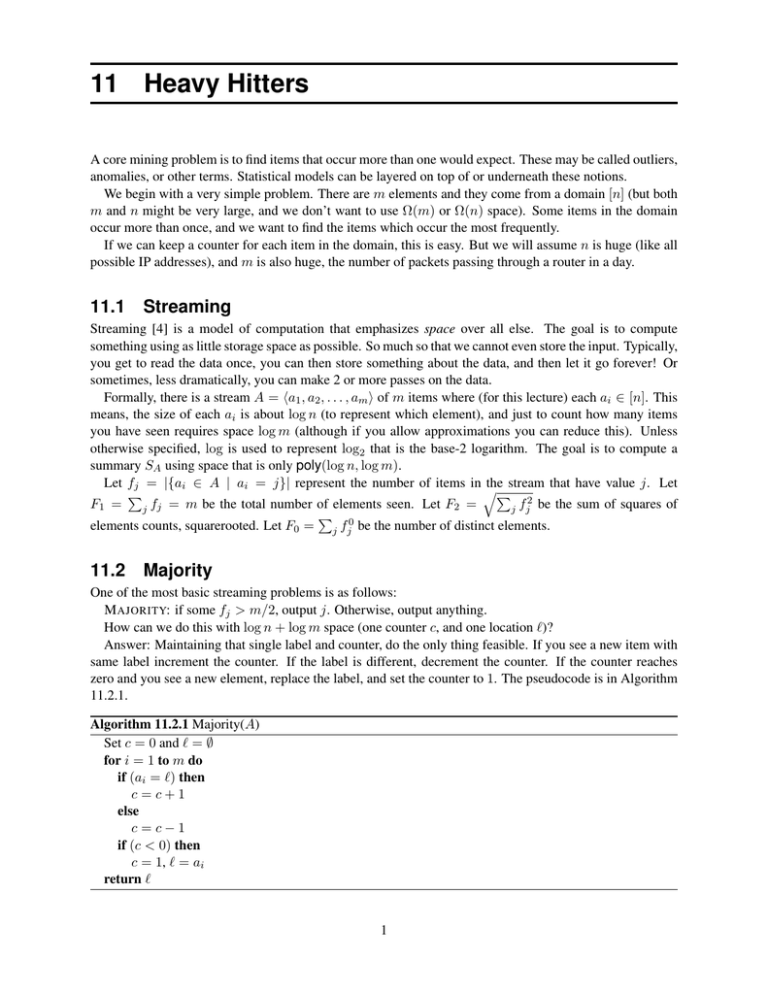11 Heavy Hitters
advertisement

11 Heavy Hitters
A core mining problem is to find items that occur more than one would expect. These may be called outliers,
anomalies, or other terms. Statistical models can be layered on top of or underneath these notions.
We begin with a very simple problem. There are m elements and they come from a domain [n] (but both
m and n might be very large, and we don’t want to use Ω(m) or Ω(n) space). Some items in the domain
occur more than once, and we want to find the items which occur the most frequently.
If we can keep a counter for each item in the domain, this is easy. But we will assume n is huge (like all
possible IP addresses), and m is also huge, the number of packets passing through a router in a day.
11.1
Streaming
Streaming [4] is a model of computation that emphasizes space over all else. The goal is to compute
something using as little storage space as possible. So much so that we cannot even store the input. Typically,
you get to read the data once, you can then store something about the data, and then let it go forever! Or
sometimes, less dramatically, you can make 2 or more passes on the data.
Formally, there is a stream A = ha1 , a2 , . . . , am i of m items where (for this lecture) each ai ∈ [n]. This
means, the size of each ai is about log n (to represent which element), and just to count how many items
you have seen requires space log m (although if you allow approximations you can reduce this). Unless
otherwise specified, log is used to represent log2 that is the base-2 logarithm. The goal is to compute a
summary SA using space that is only poly(log n, log m).
Let fj = |{ai ∈ A | ai = j}| represent the number of items in q
the stream that have value j. Let
P
P 2
F1 =
j fj = m be the total number of elements seen. Let F2 =
j fj be the sum of squares of
P 0
elements counts, squarerooted. Let F0 = j fj be the number of distinct elements.
11.2
Majority
One of the most basic streaming problems is as follows:
M AJORITY: if some fj > m/2, output j. Otherwise, output anything.
How can we do this with log n + log m space (one counter c, and one location `)?
Answer: Maintaining that single label and counter, do the only thing feasible. If you see a new item with
same label increment the counter. If the label is different, decrement the counter. If the counter reaches
zero and you see a new element, replace the label, and set the counter to 1. The pseudocode is in Algorithm
11.2.1.
Algorithm 11.2.1 Majority(A)
Set c = 0 and ` = ∅
for i = 1 to m do
if (ai = `) then
c=c+1
else
c=c−1
if (c < 0) then
c = 1, ` = ai
return `
1
Why is Algorithm 11.2.1 correct?
P Consider the case where for some j ∈ [n] we have fj > m/2, the only
relevant case. Since then fj > j 0 6=j fj we can match each stream element with ai 6= j (a “bad element”)
to another element ai0 = j (a “good element”). If we chose the correct pairing (lets assume we did) then
either the good element decremented the counter when the label was not j, or the bad element decremented
the counter when the label was j. This results in a net 0 change in the counter for each pair. Its also possible
that a bad element decremented the counter when the label was not equal to j, but this will only help. After
this cancelation, there must still be unpaired good elements, and since then the label would need to be ` = j
or the counter c = 0, they always end their turn with ` = j and the counter incremented. Thus after seeing
all stream elements, we must terminate with ` = j and c > 0.
11.3
Misra-Gries Algorithm for Heavy Hitters
Now we generalize the M AJORITY problem to something much more useful.
k-F REQUENCY-E STIMATION: Build a data structure S. For any j ∈ [n] we can return S(j) = fˆj such
that
fj − m/k ≤ fˆj ≤ fj .
From another view, a φ-heavy hitter is an element j ∈ [n] such that fj > φm. We want to build a data
structure for ε-approximate φ-heavy hitters so that it returns
• all fj such that fj > φm
• no fj such that fj < φm − εm
• (any fj such that φm − εm ≤ fj < φm can be returned, but might not be).
11.3.1
Misra-Gries Algorithm
[Misra+Gries 1982] Solves k-F REQUENCY-E STIMATION in k(log m + log n) space [3].
The trick is to run the M AJORITY algorithm, but with (k − 1) counters instead of 1. Let C be an array of
(k − 1) counters C[1], C[2], . . . , C[k − 1]. Let L be an array of (k − 1) locations L[1], L[2], . . . , L[k − 1].
• If we see a stream element that matches a label, we increment the associated counter.
• If not, and a counter is 0, we can reassign the associated label, and increment the counter.
• Finally, if all counters are non-zero, and no labels match, then we decrement all counters.
Psuedocode is provided in Algorithm 11.3.1.
Algorithm 11.3.1 Misra-Gries(A)
Set all C[i] = 0 and all L[i] = ∅
for i = 1 to m do
if (ai = L[j]) then
C[j] = C[j] + 1
else
if (some C[j] = 0) then
Set L[j] = ai & C[j] = 1
else
for j ∈ [k − 1] do C[j] = C[j] − 1
return C, L
Then on a query q ∈ [n] to C, L, if q ∈ L (specifically L[j] = q), then return fˆq = C[j]. Otherwise return
fˆq = 0.
CS 6140 Data Mining;
Spring 2016
Instructor: Jeff M. Phillips, University of Utah
Analysis:
Why is Algorithm 11.3.1 correct?
• A counter C[j] representing L[j] = q is only incremented if ai = q, so we always have
fˆq ≤ fq .
• If a counter C[j] representing L[j] = q is decremented, then k−2 other counters are also decremented,
and the current item’s count is not recorded. This happens at most m/k times: since each decrement
destroys the record of k objects, and since there are m objects total. Thus a counter C[j] representing
L[j] = q is decremented at most m/k times. Thus
fq − m/k ≤ fˆq .
We can now apply this to get an additive ε-approximate F REQUENCY-E STIMATION by setting k = 1/ε.
We return fˆq such that
|fq − fˆq | ≤ εm.
Or we can set k = 2/ε and return C[j] + (m/k)/2 to make error on both sides.
Space is (1/ε)(log m + log n), since there are (1/ε) counters and locations.
11.4
Quantiles and Frugal Algorithms
Another important but simple problem for streaming data is the quantiles problem. For this we consider the
ordering of the elements in [n] as important. In fact, its typically easier to think of each element being a real
value ai ∈ R so that they are continuously valued and we have a comparison operator <. Think of ai as
the number of milliseconds someone spent on a visit to a website before clicking a link. Or ai could be the
amount of money spent on a transaction.
Now instead of searching for frequently occurring items (since we may never see the same item twice)
it is better to treat these as draws from a continuous distribution over R. In this case, two very similar (but
perhaps not identical) values are essentially equivalent. The simplest well-defined interaction with such a
distribution is through the associated cumulative density function. That is, given any value v, we can ask
what fraction of items have value less than or equal to v. We can define the rank of v over a stream A as
rankA (v) = |{ai ∈ A | ai ≤ v}|.
Now an ε-approximate quantiles data structure QA returns a value QA (v) for all v such that
|QA (v) − rankA (v)/m| ≤ ε.
If we are not concerned about streaming, we can easily construct a data structure of size 1/ε. We simply sort all values in A, and then select a subset B of size 1/ε elements, evenly spaced in that sorted
order. Then QA (v) = rankB (v)/|B|. This is the smallest possible in general. Streaming algorithms are
known of size O((1/ε) log(1/ε)) [1] (which is the smallest possible size) and efficient variants of size
O((1/ε) log1.5 (1/ε)) [5]. By combining two such queries, we can also ask what fraction of data falls between two values v1 and v2 as QA (v2 ) − QA (v1 ).
Additionally, such a summary also encodes properties like the approximate median. This is the value for
which rankA (v)/m = 0.5 (naively one may have to find this by binary search, if the structure is a set B and
QA (v) = rankB (v)/|B|, then we can also maintain this directly. As the quantiles algorithms are a bit more
complicated to describe we will next describe some so-called Frugal Algorithms [2] which can maintain
values like the approximate median (or any other quantile) approximately without maintaining all quantiles.
Going backwards from the Misra-Gries to Majority, is akin to the idea of maintain just a Frugal sketch of
the median as opposed to all quantiles.
CS 6140 Data Mining;
Spring 2016
Instructor: Jeff M. Phillips, University of Utah
11.4.1
Frugal Median
The Frugal estimate of the median can be maintained easily as followed over an ordered set of integers. The
simplest version just maintains a single label ` ∈ [n]. Initially set ` = 0 (or any value). Then if ai > `, then
increment `. If ai < `, then decrement `. Psuedocode is in Algorithm 11.4.1.
Algorithm 11.4.1 Frugal Median(A)
Set ` = 0.
for i = 1 to m do
if (ai > `) then
` ← ` + 1.
if (ai < `) then
` ← ` − 1.
return `.
This can be generalized to any quantile, say trying to find just the value v such that rankA (v)/m = 0.75.
Then we use a bit of randomization.
Algorithm 11.4.2 Frugal Quantile(A, φ)
Set ` = 0.
for i = 1 to m do
r = U nif orm(0, 1) (at random)
if (ai > ` and r > 1 − φ) then
` ← ` + 1.
if (ai < ` and r > φ) then
` ← ` − 1.
return `.
e.g. φ = 0.75
The bounds for this algorithm are not as absolutely strong as for the Misra-Gries algorithm, but it uses far
less space. For instance, for the median version let M be the integer value of the true median, and say we
are happy with any value v such that rankA (v)/m ∈ [1/2 − ε, 1/2 + ε] for some small value ε ∈ (0, 1/2).
The with probability at least 1 − δ after M log(1/δ)
steps, our estimate will be within the desired range.
ε
The bounds are better if we start our estimate at a value closer to v ∗ than 0. Also, if we are using to use
an extra small counter, then we can adaptively change the amount we increment or decrement the label, and
decrease the number of steps we need.
CS 6140 Data Mining;
Spring 2016
Instructor: Jeff M. Phillips, University of Utah
Bibliography
[1] David Felber and Rafail Ostrovsky. A randomized online quantile summary in o(1/epsilon *
log(1/epsilon)) words. In APPROX-RANDOM, 2015.
[2] Qiang Ma, S. Muthukrishnan, and Mark Sandler. Frugal streaming for estimating quantiles. In SpaceEfficient Data Structures, Streams, and Algorithms, volume LNCS 8066, pages 77–96, 2013.
[3] J. Misra and D. Gries. Finding repeated elements. Sc. Comp. Prog., 2:143–152, 1982.
[4] S. Muthukrishnan. Data streams: Algorithms and applications. Foundations and Trends in Theoretical
Computer Science, 2003.
[5] Lu Wang, Ge Luo, Ke Yi, and Graham Cormode. Quantiles over data streams: An experimental study.
In ACM SIGMOD International Conference on Management of Data, 2013.
5




